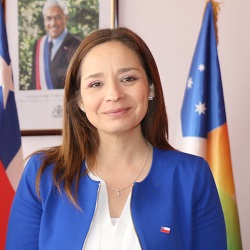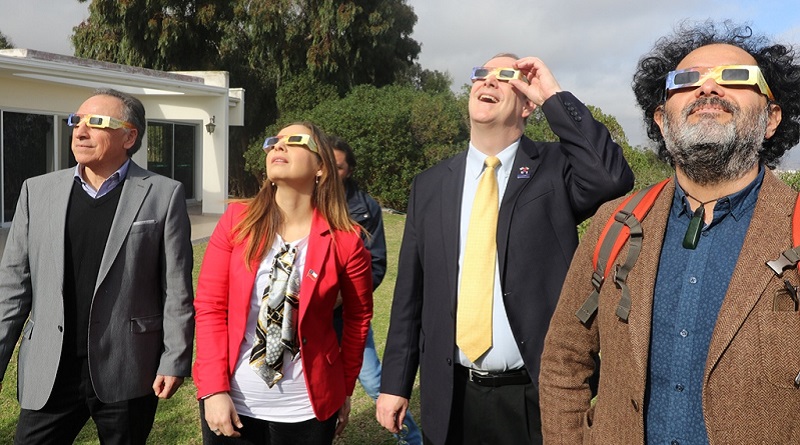Lucía Pinto is the Intendente of the Region of Coquimbo and as such its highest authority, in charge of overseeing and coordinating events of state-level importance – such as the total solar eclipse this July. Important not just because an unprecedented number of visitors are expected during the eclipse and the days before and after. More so because of the symbolic importance of the eclipse for a region keen to become (known) as leading destination for astrotourism in the world. But how to get there, and how to manage such an important event?
During my tour of Chile (following the invitation of the country’s brand agency, Imagen de Chile), I had the opportunity to sit down with the Intendente at her office in the regional capital, La Serena.
Lucía, interest in Chile as destination for astrotourism is expected to grow significantly this year, due to the total solar eclipse in July, which can be seen especially well in the Coquimbo region. Briefly, can you tell us about the role that astronomy plays for the region’s economic competitiveness and reputation?
The expectations about the solar eclipse have been growing and that’s been reflected in hotel bookings for the first week of July. Since January 12th, the bookings in La Serena, Coquimbo, Vicuña, Paihuano and La Higuera are already up 84%. The most concentrated places are Vicuña, Paihuano and Avenida del Mar in La Serena.
This nature phenomenon is a unique coincidence for the region, the country and the astrotourists of the world, who will appreciate the solar eclipse in the main astrotourism center of the southern hemisphere.
We live in a region with more than 300 clear nights each year. A pioneer in astronomy, this place is known as “the star region” or “la region Estrella” and as the astronomy tourism capital.
Every year, thousands of people from around the world come here, interested in discovering the cosmos. Today, we count 15 touristic observatories, which give visitors the exciting experience of contemplating the space. Just one example: in Elqui and Limarí astrotouristic observatories we receive more than 100 thousand visitors per year.
From an economic development perspective, which are the main opportunities for the Coquimbo region linked to the expected increase in astrotourism, and which are the key challenges – hurdles to overcome?
We expect at least 300 thousand people to visit our region, to appreciate this astronomic phenomenon, with an average stay of 5 days. We’re talking about scientists and astronomy buffs mostly, who will come with their equipment to appreciate and register the eclipse. Also, they can enjoy our valleys, shores, cities and rural surroundings.
The solar eclipse is a milestone for us in the region, but also nationally: a great opportunity to consolidate and position this activity as one of our principal Chilean exportation products, one of the assets which distinguish us from the rest of the world.
Today we are preparing our region in many ways, logistics, organization and coordination, diffusion. Also strengthening touristic conscience among locals, so we can always give the best service to our visitors. All this with different activities to complement this astronomic phenomenon, during the event and also afterwards.

Apart from astrotourism, which other experiences are you seeking to strengthen at Coquimbo region?
An important part of our work is exploiting the potential to face the phenomenon itself and all our tourist attractions, considering that the tourists will remain in our region for at least 5 days.
This region is a very special destination, full of experiences and attractions to enjoy, like enotourism associated with pisco and its production, ecotourism in wild, protected areas, and adventure tourism in shores and valleys. Also, visitors who will come to see the eclipse can enjoy our gastronomy and cultural patrimony.
We are right now enhancing the Gabriela Mistral Route by offering 10 interesting spots, each representing a life episode of our first Nobel prize winner in Chile, showing the difficulties of her poetess career and her success. We need people to really know about what an extraordinary and interesting person she was.
Which aspects of developing and promoting Coquimbo as destination domestically and internationally would you consider the most difficult?
Our region is a young destination. We are positioning ourselves internationally only since a few years and we are creating a tourism brand, which takes time.
International competitiveness is very intense. There are so many destinations travelers can choose from, offering similar activities. Astrotourism is a very powerful advantage for us in that we can offer a type of tourism experience that other countries don’t have – or have at a lower scale.
Domestic tourists identify our region principally as a beach destination. That’s good, because we have a lot of beach to offer, from Pichidangui to Punta de Choros. But for international tourists, that perception is not very wide spread, because in South America there are so many beach destinations more consolidated than us. That’s the potential: combining our strength in astrotourism, enotourism (especially linked to the pisco) and wellness tourism. This really distinguishes us from other countries and can attract more and more tourists from around the world.
Thank you, Lucía.
More about astrotourism as opportunity for the Coquimbo region in Chile here


